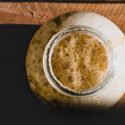What is Non Dairy Creamer: Made of, Types, Uses, and 15 FAQs

What it is and the ingredients in it | Types | Uses | Side effects | 15 FAQs
Non dairy creamer is a mixture of several food additives commonly called coffee whitener or coffee creamer. Its purpose in food is to replace the milk powder or reduce the amount of milk in coffee, milk tea, oatmeal, hot chocolate, bakery, or other beverages. Its market demand is big and the sales of cream and non-dairy creamer reached $1.35 Billion from Sep. 2018 – Sep. 2019, which is shown in FDA’s Website.
What is Non dairy creamer?
What is it made of?
According to the definition of The U.S. Department of Agriculture (USDA), non-dairy creamer powder contains the following ingredients:
- Corn syrup solids
- Vegetable fats or oils
- Sodium caseinate
- Dipotassium phosphate
- Mono-and Diglycerides
- Sodium silicoaluminate
- Lecithin
- Natural and/or artificial flavors
- Natural and/or artificial colors
It may also contain other additives like sodium tripolyphosphate, sodium stearoyl lactylate, and tricalcium phosphate. (1)
What are the functions of the above ingredients?
We can learn from the USDA’s definition, that it is a mixture of several ingredients. Let’s see the 10 sub ingredients and their functions.
1. Corn syrup solid
It is the core ingredient in the product and produced by partial hydrolysis of corn starch with acids or enzymes, its DE value is more than 20 while that of maltodextrin is less than 20. (2)
2. Vegetable fats or oils
It is another main ingredient. Vegetable oils/fats are oils extracted from seeds, or from other parts of fruits (3). It is divided into saturated oils and unsaturated oils based on whether the double or triple bonds exist in the molecules of fats.
Saturated oils
Saturated fat can be found in coconut oil, palm oil, and palm kernel oil.
Unsaturated oils
Unsaturated fats can be sourced from olive oil, peanut oil, canola oil, nuts oil, soybean oil, cottonseed oil and flaxseed oils.
1. Partially Hydrogenated Oils (PHOs)
Hydrogen is added to liquid vegetable oil to make it more solid to improve the texture, shelf life, and flavor stability of foods.
However, the process generally does not make the oil completely solid, resulting in partially hydrogenated oils. It may be used in non-dairy creamer.
But in the USA, PHOs are claimed not Generally Recognized as Safe (GRAS) since 2015 as it is the primary dietary source of artificial trans fat in processed foods which could cause thousands of heart attacks and deaths each year. (4)
2. Fully hydrogenated oils
They are solid fats that contain very low levels of trans fat. (5)
3. Sodium caseinate
A milk derivative protein made from fresh milk by purification of casein and can be used as a water-soluble emulsifier, stabilizer, and also a protein supplement in a wide food applications, such as coffee whiteners, infant formulas, processed cheese, vitamin and mineral tablets, meat, beverage and so on.
4. Dipotassium phosphate
E number E340. It is a highly water-soluble dipotassium salt with the chemical formula K2HPO4. It functions as a stabilizer to prevent coagulation in non-dairy creamer.
5. Mono-and Diglycerides
A common emulsifier with E number E471.
6. Sodium silicoaluminate
E number E554. Also called sodium aluminosilicate, is an anticaking agent that provides the free flow of non dairy creamer.
7. Lecithin
It functions as an emulsifier and antioxidant with the E number E322.
8. Sodium tripolyphosphate
Act as an anticaking agent with E number E451. It can also be used as an emulsifier, stabilizer, thickener and PH control agent in food applications. (6)
9. Sodium stearoyl lactylate
A common emulsifier with E number E481.
10. Tricalcium phosphate
E number E341. It is the calcium salt of phosphoric acid, known as TCP, primarily used as a source of calcium supplement, and also acts as an anticaking agent in non dairy creamer.
Types of non dairy creamer
There are many types of non dairy creamer as the proportion of sub ingredients can be adjusted according to the specific uses. The oil source, the fat content, sodium caseinate assay, the color, and the flavor can be various.
For example, according to the fat content, it can be divided into three types: low fat, medium fat and high fat.
| Types | Fat Content |
| Low fat | 5%-20% |
| Medium fat | 21%-50% |
| High fat | 51%-80% |
It can also be categorized by the application: coffee, chocolate, ice cream, milk tea, bakery food, cereal, confectionery and so on.
Properties
Appearance
It is a white to light cream color.
Solubility in water
It is readily dissolved in water at 79 to 82°C (175 to 180°F), and without occurring of curdling, feathering, or undissolved floating particles.
What are Uses of non dairy creamer?
Due to its excellent properties, such as good water solubility, emulsification function and foaming ability, non dairy creamer meets the processing needs for various food applications. It is widely used in coffee, milk tea, ice cream, bakery, and so on.
Coffee
It can improve the color and increase whiteness in coffee. Also, it has a strong milk flavor and can provide the soft taste.
Milk Tea
It helps milk tea create smoothness and creamy bubbles. Meanwhile, it can improve the bitter taste of tea, and improve the color of gruel of millet flour and sugar, also adding silky bright color.
Ice Cream
It has following benefits to ice cream:
- Increase the volume of ice cream
- Keep ice cream stable, shape and avoid thawing and without forming big crystal
- Whiten and make ice cream creamier
Bakery
It is the same function as an emulsifier, it can improve the structure and physical properties of the baked products, making the appearance looks good. Also it can prolong the shelf life for the bakery.
What are the possible side effects?
It is common that sometimes consumers have concerns about whether the ingredient non dairy creamer they’re eating in the food is bad for the health and what are the dangers. Generally, it is safe and the health risks focus on sodium caseinate allergy, lactose intolerance and trans fat.
Allergy
Sodium caseinate is identified as a milk allergen (7). The following allergic symptoms may occur (8):
- Hives
- Stomach upset
- Vomiting
- Bloody stools, especially in infants
- Anaphylaxis
Lactose intolerant
From FDA’s information, a person may have the following symptoms if there is not enough lactase to digest the lactose in food:
- gas
- stomach cramps
- bloating
- nausea
- diarrhea
Trans fat
It may contain trans fat and the source of trans fat is from vegetable oils or fats. Trans fat is an unhealthy fat that is made during the chemical process of partial hydrogenation of oils.
It will increase our bad (LDL) cholesterol while lowering the good (HDL) cholesterol, in this way, it boosts our risk of heart disease and stroke. It may also lead to type 2 diabetes. (9)
Is it safe for pregnant and breastfeeding?
It is generally safe, better consult with your doctor.
Frequently asked questions
Does it contain milk?
No, we can see from its definition that it does not contain milk although the sub ingredient sodium caseinate is derived from milk.
Is coffee mate the same as non dairy creamer?
Generally, coffee mate is similar with non dairy creamer as they’re both mixed with the same or a little different ingredients.
In some products and brands, we can generally treat coffee mate as a non dairy creamer, such as based on the information from Nestle’s ingredients list of Coffee-mate Original Powdered Creamer Canister 12 x 11 oz, the only difference in ingredients list is coffee mate without containing lecithin compared with non dairy creamer’s definition from USDA.
Difference: coffee mate is a commercial product that we can buy in supermarket while non dairy creamer is sold as a raw material.
How is non dairy creamer Made?
The brief production flows as follows:
- Mixing of ingredients which are mentioned in the definition
- Homogenization of mixture
- Spray drying
Is it lactose free?
Yes, it is lactose free and that’s why it is called “non dairy”. But it may contain low levels of lactose due to the manufacturing process of sodium caseinate, which is claimed by FDA. And powdered coffee creamers and whipped toppings may contain low levels of lactose. (10)
What is the substitute of non dairy creamer?
It is complicated to totally replace non dairy creamer in a specific application with a single food additive or a material as non dairy creamer contains not less than nine ingredients.
Why does it contain milk?
As it contains sodium caseinate which comes from milk. As specified by FDA 21CFR101.4, “the term “non dairy” on a creamer that contains sodium caseinate, it shall include a parenthetical term such as “a milk derivative” after the listing of sodium caseinate in the ingredient list.”
Dairy Vs non dairy creamer?
Non-dairy creamer is a milk substitute that has good instant solubility, strong “milk” taste, and can reduce manufacturers’ production cost while maintaining similar quality compared with using milk.
Does it have Calcium?
It has calcium if tricalcium phosphate in it.
Is it good for diabetics?
Glucose syrup, the ingredient in it may increase the risk of blood sugar, blood pressure and obesity. So it is not good for diabetics.
How much sugar in it?
Almost zero, the real number depends on the hydrolysis of corn starch and the percentage of corn syrup in non dairy creamer. It is also claimed by Nestle that the original coffee mate has zero sugar.
Is it Natural?
Obviously it is not natural. Most of the sub ingredients are manufactured from chemical synthesis.
Is it Vegan?
Commonly we think it is vegan simply from its name indicating “Non dairy”. But it is not really dairy free and so not vegan. As mentioned above, it has the milk derived ingredient sodium caseinate in it. So vegetarians should avoid it.
Is it Halal?
Yes, it is halal and we can find several suppliers certificated with MUI halal in www.halalmui.org.
Is it Kosher?
Pareve is a classification of edible substances that contain neither dairy nor meat ingredients. Other ingredients in non dairy cream are kosher except sodium caseinate, a milk derived protein. From the OU Kosher explanation, non dairy creamer has a D (For Dairy) kosher certification. (11)
Is it Gluten free?
Yes, it is gluten free or without gluten as comply with the following conditions listed by FDA, without contain wheat, rye, barley, or crossbreeds of these grains. (12)
Conclusion
Now you may have a knowledge of the emulsifier & coffee whitener – Non Dairy Creamer, from its production; 10 compositions; types; uses; approved safety, possible side effects and some FAQs such as is it vegan, whether dairy free or contain milk and so on.
What kinds of food packaging have you found this ingredient in? Let me know in the comments.



HI, JAMES…
Thanks so much for your valuable detailed info on the Non-Dairy Coffee Creamer.
I would just like to ask if other powders that i can use as a base for making chai tea or green tea latte powders, besides the non-dairy creamer. I’ve been using the horchata (rice powder) sold cheaply in bulk here in los angeles produce market (50lb), but it’s terribly sweet (too much sugar added). But it has the advantage of being made of just the refined rice powder, sugar and cinnamon. and also the rice taste of flavor is noticeable. I’d appreciate any help or info in this matter. Thanks a lot.. Joshua (Josue) (from Tribal Cafe espresso bar here in Los Angeles, CA)
Hi Jose, can you please let me know more about your request?
Thanks James,I got many knowledge about food additives.
Is there a creamy without soy I’m allergic to gluten and soy I’m also allergic to dairy